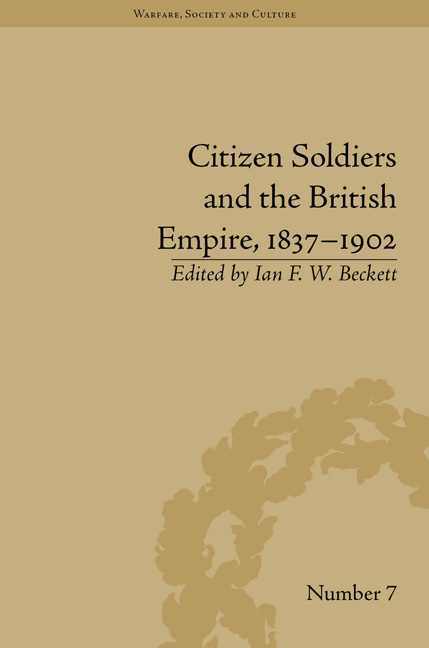Refine search
Actions for selected content:
15418 results in Military history
Dedication
-
- Book:
- Military Manpower, Armies and Warfare in South Asia
- Published by:
- Pickering & Chatto
- Published online:
- 05 December 2014, pp vi-vi
-
- Chapter
- Export citation
3 - Australia
-
-
- Book:
- Citizen Soldiers and the British Empire, 1837–1902
- Published by:
- Pickering & Chatto
- Published online:
- 05 December 2014, pp 57-78
-
- Chapter
- Export citation
Acknowledgements
-
- Book:
- Military Manpower, Armies and Warfare in South Asia
- Published by:
- Pickering & Chatto
- Published online:
- 05 December 2014, pp vii-viii
-
- Chapter
- Export citation
1 - Britain
-
-
- Book:
- Citizen Soldiers and the British Empire, 1837–1902
- Published by:
- Pickering & Chatto
- Published online:
- 05 December 2014, pp 23-40
-
- Chapter
- Export citation
6 - Postcolonial Militaries, 1947–2012
-
- Book:
- Military Manpower, Armies and Warfare in South Asia
- Published by:
- Pickering & Chatto
- Published online:
- 05 December 2014, pp 121-132
-
- Chapter
- Export citation
4 - The Era of European Military Entrepreneurs, 1700–1850
-
- Book:
- Military Manpower, Armies and Warfare in South Asia
- Published by:
- Pickering & Chatto
- Published online:
- 05 December 2014, pp 71-90
-
- Chapter
- Export citation
Introduction
-
- Book:
- Alexander Leslie and the Scottish Generals of the Thirty Years' War, 1618–1648
- Published by:
- Pickering & Chatto
- Published online:
- 05 December 2014, pp 1-10
-
- Chapter
- Export citation
5 - The Regimental System of Recruitment, c. 1700–1947
-
- Book:
- Military Manpower, Armies and Warfare in South Asia
- Published by:
- Pickering & Chatto
- Published online:
- 05 December 2014, pp 91-120
-
- Chapter
- Export citation

Citizen Soldiers and the British Empire, 1837–1902
-
- Published by:
- Pickering & Chatto
- Published online:
- 05 December 2014
-
- Book
- Export citation
Frontmatter
-
- Book:
- War and the Militarization of British Army Medicine, 1793–1830
- Published by:
- Pickering & Chatto
- Published online:
- 05 December 2014, pp i-iv
-
- Chapter
- Export citation
1 - Scotland's Indigenous Military Cultures
-
- Book:
- Alexander Leslie and the Scottish Generals of the Thirty Years' War, 1618–1648
- Published by:
- Pickering & Chatto
- Published online:
- 05 December 2014, pp 11-24
-
- Chapter
- Export citation
Glossary
-
- Book:
- Military Manpower, Armies and Warfare in South Asia
- Published by:
- Pickering & Chatto
- Published online:
- 05 December 2014, pp 167-170
-
- Chapter
- Export citation
Notes
-
- Book:
- War and the Militarization of British Army Medicine, 1793–1830
- Published by:
- Pickering & Chatto
- Published online:
- 05 December 2014, pp 159-194
-
- Chapter
- Export citation
8 - The South African War, 1899–1902
-
-
- Book:
- Citizen Soldiers and the British Empire, 1837–1902
- Published by:
- Pickering & Chatto
- Published online:
- 05 December 2014, pp 155-170
-
- Chapter
- Export citation
CONTENTS
-
- Book:
- Citizen Soldiers and the British Empire, 1837–1902
- Published by:
- Pickering & Chatto
- Published online:
- 05 December 2014, pp v-vi
-
- Chapter
- Export citation
Introduction
-
- Book:
- Military Manpower, Armies and Warfare in South Asia
- Published by:
- Pickering & Chatto
- Published online:
- 05 December 2014, pp 1-8
-
- Chapter
- Export citation
5 - James McGrigor in the Peninsula
-
- Book:
- War and the Militarization of British Army Medicine, 1793–1830
- Published by:
- Pickering & Chatto
- Published online:
- 05 December 2014, pp 103-126
-
- Chapter
- Export citation
2 - Walcheren and the Army Medical Board
-
- Book:
- War and the Militarization of British Army Medicine, 1793–1830
- Published by:
- Pickering & Chatto
- Published online:
- 05 December 2014, pp 31-50
-
- Chapter
- Export citation
Introduction
-
- Book:
- War and the Militarization of British Army Medicine, 1793–1830
- Published by:
- Pickering & Chatto
- Published online:
- 05 December 2014, pp 1-10
-
- Chapter
- Export citation
Frontmatter
-
- Book:
- Alexander Leslie and the Scottish Generals of the Thirty Years' War, 1618–1648
- Published by:
- Pickering & Chatto
- Published online:
- 05 December 2014, pp i-iv
-
- Chapter
- Export citation
